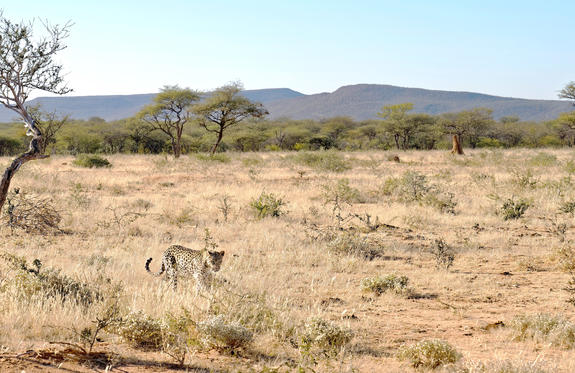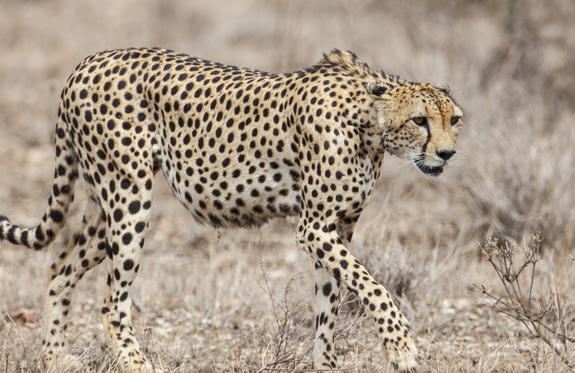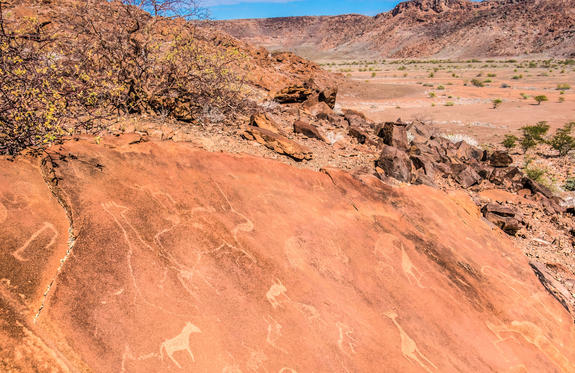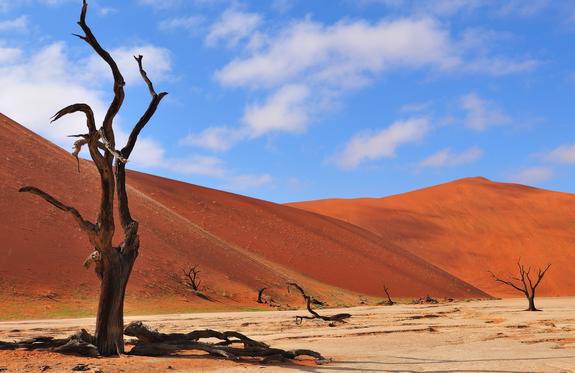
Windhoek is Namibia’s capital, home to an international airport and a plethora of restaurants, shops, entertainment venues and accommodation options. The city is clean, safe and well-organised, with a colonial legacy that is reflected in its many German eateries and shops, and the widespread use of the German language. Windhoek has an interesting mix of historical architecture and modern buildings, many of which are worth a look, including the Alte Feste (Old Fort), the 1896 Christuskirche (Christ Church), and the more contemporary Supreme Court.

Halfway between Windhoek and Etosha lies the well-known Okonjima Nature Reserve. The 22 000 ha Nature Reserve is surrounded by 96 km of fence and was finally completed in 2010. Okonjima is home to AFRICAT, a Carnivore Conservation, which gives the captive carnivores a second chance to be released back into the wild and to take the time it needs, to become a completely independent hunter - in a protected area right in the middle of commercial farmland! Also in the Reserve is a 2000 ha 'safe' zone around Plains Camp, Bush Camp, Bush Suite, the Omboroko Campsite as well as the PAWS Environmental Education Centre.

Situated on the eastern side of Etosha, bordering Fisher's Pan, Onguma Game Reserve is one of Namibia's best kept secrets! Here you will be afforded the opportunity of experiencing Africa in all her beauty and diversity. Onguma Game Reserve has more than 34,000 hectares of protected land and wildlife. Our nature reserve boasts over thirty different animal species consisting of plains game including kudu, giraffe, eland, oryx, hartebeest, zebra, impala and many more roam freely as well as predators such as lion, cheetah, leopard, being common residents of the area. The latest addition to the already abundant wildlife at Onguma Game Reserve is a family of black rhinos! More than 300 bird species can also be viewed at Onguma Game Reserve. During the Namibian summer months, the nature reserve becomes a bird-watcher's paradise with thousands of species migrating to the wetlands created by the seasonal rains and ephemeral river systems.

Located just south of the boundary of Etosha National Park in north-western Namibia, Etosha South makes up the southern region of this wild paradise. The national park can be accessed via the southern entrance at Andersson’s Gate. Visitors can catch a glimpse of a variety of wildlife including lion, giraffe, elephant, white and black rhino, and a multitude of plains game. Popular activities include game drives, tracking rhinos on foot, guided nature walks, or watch the sunset over this magnificent landscape.
ETOSHA NATIONAL PARK
Entrance fees to the park are to be paid at the accommodation in the park. Day visitors are required to pay their fee at the reception of the nearest camp from where they enter. Visitors entering the park through the Galton Gate will pay directly at the gate (fees subject to change without prior notice):
- Adults: NAD 150 per adult per day
- Children under 16 years: NAD 100 per child per day
- Vehicles with 10 seats or less: NAD 50 per vehicle per day
- Guests must report to reception on arrival
- Accommodation is available from 12:00 PM and must be vacated by 10:00 AM.
Please Note: When entering Etosha National Park, every visitor has to show proof of identification, either in the form of a passport, driver’s license or ID, due to the poaching incidents.
When on game drives:
- Remain in your vehicle at all times
- Obey all the traffic signs in the park
- Only persons with a valid driver’s licence are permitted to drive in the park
- No wildlife or plants may be removed from the park
- Arrive back in your camp before sunset. You are only allowed to leave the camp after sunrise again
- The speed limit in the park is 60 km/h.
The following are not allowed in the park:
- No plastic bags
- No drones
- No pets
- No firearms or projectile- shooting weapons
- No motorcycles
- No littering
- No feeding of the wild animals
- Silence is required around the waterholes and check to make sure before heading out that waterholes are open for viewing.
Etosha National Park is accessible through four gates:
- Anderson’s Gate is on the southern end of the park and can be reached on the C38 via Outjo. The closest camp is Okaukuejo.
- Von Lindequist Gate lies in the east and connects to the B1. Tsumeb is the closest town to this gate and Namutoni Camp is only a short drive from the gate.
- Galton Gate lies on the south-western end of the park.
- King Nehale Lya Mpingana Gate is in the northern end of the park and is 48km from the main road to Ondangwa.
Opening times and closing times:
The times change weekly and are based on Sunrise and Sunset.
Facilities:
- Restaurant & Bar 07:00-09:00 & 12:00-14:00 & 18:00-22:00
- Kiosk (open, when restaurants are closed)
- Shops opening hours 07:00-08:00 & 12:00-13:30 & 18:00-20:30.

Twyfelfontein (meaning "doubtful fountain"), is a massive, open air art gallery. With over 2,000 rock engravings, Twyfelfontein represent one of the largest and most important rock art concentrations in Africa. In June 2007 this striking natural red-rock gallery of tumbled boulders, smooth surfaces and history etched in stone was awarded World Heritage Site status, making it Namibia’s first and only UNESCO World Heritage Site to date. The engravings are estimated to be up to 6,000 years old, and it is believed by many that their creators were San medicine people or shamans, who created their engravings as a means of recording the shaman’s experience among the spirits while in a trance. Among the most celebrated of the rock engravings at Twyfelfontein are a giant giraffe, a "lion man" with a hand at the end of its tail, and a dancing kudu.

Founded in 1892 as the main harbour for German South West Africa, Swakopmund is often described as being more German than Germany. Now a seaside resort, Swakopmund is the capital of the Skeleton Coast tourism area and has plenty to keep visitors happy. The quirky mix of German and Namibian influences, colonial-era buildings and the cool sea breeze make it very popular.

Sossusvlei is where you will find the iconic red sand dunes of the Namib. The clear blue skies contrast with the giant red sand dunes to make this one of the natural wonders of Africa and a photographers heaven. Aside from the attractions at Sossusvlei - Dune 45, Hiddenvlei, Big Daddy and Deadvlei - other attractions in the area include the Sesriem Canyon and Namib-Naukluft National Park, where the mountains of the Namib meet its plains.

Spanning an area of 172,200 hectares and encompassing four distinct ecosystems, the Namib Rand Reserve is among the largest privately-owned game parks in Southern Africa. Founded to conserve the unique environment and wildlife species of the south-western Namib Desert, the park’s mix of dunes, mountains, rocky outcrops, sandy flats and gravel plains provides habitats for a diversity of mammals – including hyenas, jackals, foxes, antelopes and various wild cats – as well as a plethora of bird species, reptiles, insects, frogs and flora. Visitors can discover the mysterious ‘fairy circles’, which dot the landscape and sip on sundowners while watching the sunset over this unspoilt ancient landscape. Having been named Africa’s first International Dark Sky Reserve, it is one of the least light-polluted areas in the world, so don't miss this excellent star gazing opportunity.



